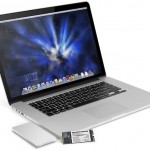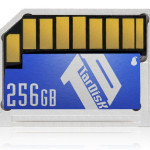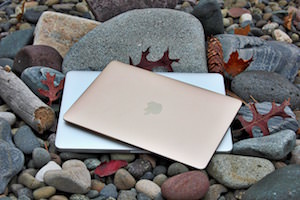When Apple introduced its MacBooks with built-in flash storage that starts at just 128 gigabytes, the question became: “Is 128GB enough for me?”
Tough question. The answer in most cases? Probably. And maybe it’s even more than enough. But it might be far too little, too. Here’s how to figure it out:
Do you take a lot of photos? A lot of video?

TarDisk is an easy integrated storage upgrade for MacBook Air and MacBook Pro: Use code WICKEDDISCOUNT to get 10% off today.
If you take a lot of photos and video and store them on your hard drive, find out how many gigabytes (GB) they take up. In iPhoto, you can select your events or photos and click on the View menu to “Get Info.” You should be able to see how many photos you have total and the storage space they take up. If you’re using Apple’s newer Photos app, you can find out how much storage space your photos and video take up by opening Photos, then clicking on the Photos menu at the top left, choosing Preferences, then clicking on the General selection. Click the Show in Finder button, which will show you your Photos Library. Make sure this library file is selected, then go to the top left of your screen and choose File, then Get Info. The resulting window will show you the size of your Photos library.
I have more than 24,000 photos and videos that take up 230GB of storage space.
So is 128GB enough for me? No way.
Most people have far less photos, though.
It is possible to offload photos to a fast external hard drive or one of the cost-effective USB 3.0 flash “thumb” drives, which now store up to 256GB at reasonable prices — check out, “Best External Hard Drive for Macs, Plus 256GB Flash Drives” for more detail.
You can even store your iPhoto or Photos library on a connected hard drive. I don’t like to, though. I prefer the simplicity of keeping it all on one drive, in my MacBook Pro, which also makes it easier to backup. Downside is, Apple’s move to super-fast solid-state hard drives (flash storage) means that the company is stingy with its drive space in its entry-level models.
What’s worse is that it’s not easy to upgrade SSDs like old-school (slower) hard drives.
What about Apple’s iCloud for storage?
Another option is to upgrade your iCloud storage and store all your photos in iCloud with optimized smaller images on your MacBook. This is a great service, but you’ll pay every month. For me, that’s $9.99 a month, which is $120 a year . . . forever. And if I ever have trouble accessing my iCloud account, I’m not sure I’ll be able to navigate Apple’s security hoops — or that family or loved ones will be able to if, say, I were hit by a bus.
Should I spend more and get 256GB or 512GB instead?
Again, tough question. The price leap into 256GB to a new MacBook Pro or MacBook Air is a good idea for regular people (non-professionals) in these three situations:
- You have a lot of photos and video . . . and you’ll likely be taking more photos and video.
- You don’t like the idea of sorting and storing photos and video on external hard drives.
- You have a lot of movies or TV shows and you want them easily available because you don’t have fast Internet access for streaming or downloading.
The good news is, new Thunderbolt and USB-C hard drives are wicked fast — and good USB 3.0 drives are nearly as fast — both which will ease your photo access and transfer pain. Still, it’s not as portable, and you’ll have to pay attention to what, where, and how you’re storing your files. To me, the ease of management is worth a couple hundred dollars over the course of my usual 3-to-4-year MacBook Pro lifespan between upgrades.

If you have a MacBook Air or Pro that has run out of storage, don’t despair — OWC may have an upgrade kit for your MacBook model.
If you find yourself with a MacBook Air or MacBook Pro that has run out of storage and you simply need more, don’t despair — Other World Computing (OWC) has upgrade kits for the MacBook Air and MacBook Pro that you can use to upgrade your built-in storage. It’s not exactly difficult but it’s not exactly easy, either. Any time you crack your case you run the risk of accidentally breaking something important or expensive. Fortunately, OWC includes the tools you need for opening your MacBook and installing new storage. Plus, you’ll get a handy enclosure for your old SSD storage, giving you a sweet little external drive.
Update: Transcend is now offering upgrade kits for some MacBook Air and MacBook Pro models — but none are available for the newest MacBook models yet.
What About Using Your SDXC Card Slot for More Mac Storage?
If you want more on-board, nearly built-in storage, you have two cool options, both of which are tiny flash-based drives in the shape of camera memory cards. They plug into the SDXC card slot on your older generations of MacBook Air or MacBook Pro — the newest MacBooks and MacBook Pros no longer have SDXC card slots. They only have USB-C ports.

The TarDisk Pear system is a tiny drive that you can combine with your built-in drive to create a single “fused” storage system on your MacBook Air or Pro.
For all intents and purposes, the Transcend JetDrive Lite acts like a little USB thumb drive — but it fits flush into the SDXC card slot instead and appears on your Mac like an external drive that is always on, always available. It appears as a separate storage option to your Mac’s operating system. Quite handy.
The TarDisk Pear system, on the other hand, also uses the SDXC card slot but it combines with your built-in storage to form a single “fused” drive. If you want a near-permanent — but easy storage solution for your MacBook Air or Pro, the TarDisk Pear system might be your best bet.
Of course, if you use your SDXC card slot for loading photos, you can pick up a small USB-based card reader like the Kingston Digital MobileLite G4 Card Reader to easily load photos and video off of your SD camera cards through a USB port.
Final 128GB Recommendation?
If you will start taking a lot of photos and video — especially if you use an iPhone 6 or 7 that lets you do things like shoot HD video at 60fps — spend the $200 extra to bump yourself up into the next model of MacBook Air, MacBook, or MacBook Pro and get 256GB of storage. If you buy from a third-party (like B&H) that often offers a slight discount and free shipping, you can lower the total cost at time of purchase to help offset the hit to your budget. For instance, at a third-party online store like B&H, you can often get into a 13-inch MacBook Pro with Retina display or with Touch Bar with 256GB of storage for about $100 less than Apple’s price and only about $100 more than Apple’s 128GB version. If you consider drive time and fuel to get to an Apple store, along with B&H’s free shipping and the likelihood that you won’t be charged sales tax . . . suddenly you might get the savings you need to get into the right MacBook for you.








